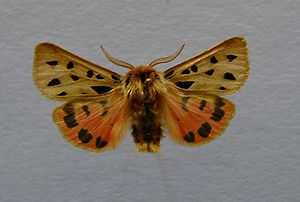Black spotted bear
| Black spotted bear | ||||||||||||
|---|---|---|---|---|---|---|---|---|---|---|---|---|

Black-spotted bear ( Chelis maculosa ) |
||||||||||||
| Systematics | ||||||||||||
|
||||||||||||
| Scientific name | ||||||||||||
| Chelis maculosa | ||||||||||||
| ( Gerning , 1780) |
The black- spotted bear or spotted bear ( Chelis maculosa ) is a moth from the subfamily of the bear moth (Arctiinae).
features
The moths reach a wingspan of 32 to 34 millimeters. Their front wings are light brown and have triangular or square, but also rounded black spots. The wings of the females are slightly darker in color. The points are usually arranged in three rows. The hind wings are dark pink and have, especially on the edge, larger black, somewhat gray spots. The fur around the head, which is also light brown, has three black vertical stripes, with the middle one being significantly wider.
The caterpillars are about 25 millimeters long. They are gray or gray-brown in color and have a rust-brown vertical stripe on the back and small spots of the same color on the sides. Her hair is gray, medium length and arranged in tufts.
Similar species
- Swiss Alpine Bear ( Chelis simplonica )
- Southern bear ( Cymbalophora pudica )
habitat
They live in very warm, only slightly overgrown, steppe-like terrain and on sandy soil. They occur predominantly in southeastern Europe to Hungary and in the southern Alps . In Germany they have disappeared in many places and are only found in the Kyffhäuser area and in Brandenburg . They are also very rarely found in Valais , in Switzerland . They fly between June and August, depending on the inhabited altitude.
Way of life
The animals are nocturnal. They make up one generation per year, and two in the warm, southern regions. At high altitudes in the Alps, they need two years to develop. The males are easily lured with artificial light. The females are very lazy and live mainly in the low vegetation, near their hatchery.
The females drop their 100 or so eggs from their resting place. These form a pile on the ground. The caterpillars stay in the dense vegetation close to the ground during the day and climb onto their forage plants at night. They overwinter before they pupate in a loose web on the ground. The caterpillar skin remains hanging on the rear end of the very mobile, whitish pupa.
The larvae mainly eat real bedstraw ( Galium verum ) but also other bedstraws .
swell
literature
- Heiko Bellmann : The new Kosmos butterfly guide. Butterflies, caterpillars and forage plants. Franckh-Kosmos, Stuttgart 2003, ISBN 3-440-09330-1 .
- Manfred Koch : We determine butterflies. Volume 2: Bears, Spinners, Swarmers and Drills in Germany. 2nd, expanded edition. Neumann, Radebeul / Berlin 1964, DNB 452481929 .
Web links
- www.schmetterling-raupe.de
- Moths and Butterflies of Europe and North Africa (English)
- Chelis maculosa at Fauna Europaea